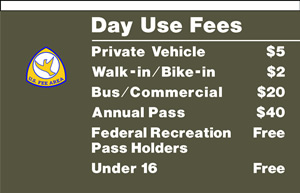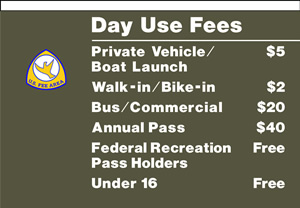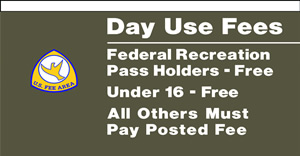Chapter 9 of Engineering Circular (EC 1130-2-550) outlines a revised fee schedule for day-use areas. To communicate this to the public through signage, the Sign Advisory Work Group and the National Sign Program Manager have worked with HQUSACE to revise sign legends.
An initial announcement of the modified format was released in December’s copy of The Sign Post. With the number of questions received about the new signs, it has become clear that further guidance is warranted.
Below are some further examples of fee signage with the new verbiage and fee schedules. Consult the Engineering Circular and compare its guidance with the actual layout of your individual day-use facilities to determine which option will best serve each day-use area.
1. General Fees

This option was included in the Winter 2015 issue of The Sign Post. The article specified that some lines are mandatory while others are not. The line Federal Recreation Pass Holders… Free, for example, is required, while the Annual Pass… $40 line is not required, if the pass is not sold at that location. As this template has many available options, select only the lines that apply to the recreation area where the sign will be installed.
2. General Fees with Boat Launch Option

This option is similar to Option 1 above, except that it includes specific wording for the boat launch. This template has the most options listed; therefore, select only the lines that apply to the recreation area where the sign will be installed.
3. Unmanned Boat Launch Only

This is a sign that may be used at unmanned boat launches where boaters won’t have already passed through a gate and paid.
4. Generic General Use

This sign is used to direct visitors to the pay station, where a listing of fees will be posted separately.
Fee Signs
The primary purpose of the fee signs is to fulfil the requirement set forth in EP 1130-2-550, Chapter 9, which states “All areas designated as recreation use fee areas will be marked in accordance with the standards set forth in the Corps of Engineers sign manual. The U.S. Fee Area symbol will be displayed at the entrance to designated use fee areas and will be installed prior to collection of fees in the area” (9-3.f (2)). The purpose of this requirement is to make sure that upon entry to a recreation use fee area, visitors are informed that if they proceed, they are choosing to pay the required fees.
This requirement is most easily met by posting the U.S. Fee Area symbol by itself at the entrance to the recreation area (found on page 7-6 of the Sign Standards Manual), prior to stopping at the pay station. A second sign with an itemized listing of the applicable fees and passes will be posted at the pay station itself—at or on the fee booth, a kiosk, a bulletin board, or as a stand-alone sign.
The newly issued signs, which include wording for the Federal Recreation passes (America the Beautiful Pass and Corps Annual Pass) and a revised fee schedule, are intended to fill the role of the second sign mentioned above. Notice that the prescribed legends are 1 inch, 1 ½ inches, and 2 inches. They are intended for installation at a pay station—manned or unmanned—where a vehicle or person on foot stops to pay. The signs are not designed for moving traffic.
Give your best effort to follow these standards. When possible, use your supervisor and other rangers at your project as an extra set of eyes to meet the requirements. When the “by the book” solutions will not work for a particular site location, get an extra set of eyes from your supervisor and other rangers at your project. Come up with an answer that comes as close as possible to the standards and consult your district Sign Program Manager for approval. Document your reason for variance in your Sign Plan and proceed to order and install your signs.
Brief Legend Length
Remember, brief sign legends are best. We are reminded that “sign messages should be concise, preferably no more than ten words” (Sign Standards Manual, p. 2-2). The idea is to have as few words as possible while still communicating a clear message. Remember that the first-time visitor is your target audience, so clarity and simplicity are key. Based on research and experience, the fewer words on a sign, the greater the likelihood that people will read and retain the entire sign message.
These fee signs consist of a “pick list,” or menu, of line items. Select the line items that apply to each given recreation area. If an item doesn’t apply to the recreation area, omit it from the sign you are ordering.
Keep in mind that you have more latitude when placing information on bulletin boards and kiosks. Although they should look neat in appearance, the Sign Standards Manual does not place restrictions on the content of bulletin boards. The fee signs with the longer legends have a quasi-bulletin-board function, geared toward visitors reading them from the seat of a stopped vehicle, or standing in front of them.
SignPro
As of 1 April 2016, these signs are not yet in SignPro. We are working to get that fixed, but until that occurs, you will need to enter the sign in SignPro with a custom legend. Place any notes you need to in order to communicate the sign’s legend and that it needs the U.S. Fee Area symbol. The Corps sign shops and UNICOR are equipped to make these signs according to the standard signs listed above.



